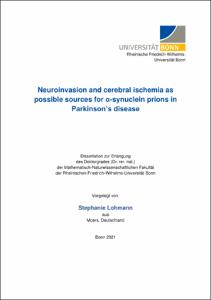Neuroinvasion and cerebral ischemia as possible sources for α-synuclein prions in Parkinson’s disease

Neuroinvasion and cerebral ischemia as possible sources for α-synuclein prions in Parkinson’s disease

| dc.contributor.advisor | Gültekin Tamgüney, Erdem | |
| dc.contributor.author | Lohmann, Stephanie | |
| dc.date.accessioned | 2021-07-13T15:12:24Z | |
| dc.date.available | 2022-07-15T22:00:23Z | |
| dc.date.issued | 13.07.2021 | |
| dc.identifier.uri | https://hdl.handle.net/20.500.11811/9218 | |
| dc.description.abstract | In synucleinopathies such as Parkinson’s disease misfolding of α-synuclein, normally a cellular and soluble protein, leads to the accumulation of insoluble protein aggregates and to central nervous system disease (CNS). Misfolded α-synuclein acts as a seed, by recruiting native α-synuclein and inducing its misfolding into insoluble α-synuclein aggregates. Aggregated α-synuclein shows prion-like characteristics and spreads via cell-to-cell transmission throughout the central nervous system but also within the periphery, ultimately causing neurological disease. Because the spatiotemporal spreading of pathological α-synuclein from the periphery to the CNS is not fully elucidated this work investigated and compared the spreading of pathological α-synuclein after intravenous or oral inoculation with that after intracerebral or intraperitoneal inoculation of TgM83+/- mice overexpressing the A53T mutant of human α-synuclein with α-synuclein fibrils. In accordance with previous studies, an infection rate of 100% was observed for intracerebrally and intraperitoneally injected mice. Moreover, this study is the first to show that a single intravenous injection of α-synuclein fibrils causes synucleinopathy in 100% of the challenged mice, and even a single oral gavage with α-synuclein fibrils results in 50% of the challenged mice in neurological disease. Diseased mice displayed aggregates of sarkosyl-insoluble and phosphorylated α-synuclein, which colocalized with ubiquitin and p62 and were accompanied by gliosis, indicative of neuroinflammation, throughout the CNS. In contrast, none of the control mice that were challenged with bovine serum albumin via the same routes developed any neurological disease or neuropathology. These findings show that aggregated α-synuclein behaves like a prion causing neuropathology and CNS disease, not only after intracerebral or intraperitoneal challenge but also by neuroinvasion after a single intravenous, or oral challenge. Since cerebral ischemia increases the risk of developing Parkinson’s disease (PD) without being clear what the underlying mechanism is, the second aim of this work was to study the impact of ischemic stroke on α-synuclein aggregation, which is known to cause PD. To investigate post-ischemic changes to the CNS, focal cerebral ischemia was induced by middle cerebral artery occlusion (MCAO) in transgenic mice overexpressing the A53T mutant of human of α-synuclein. Ischemic mice displayed significant motor deficits and loss of dopaminergic neurons in the substantia nigra at 360 days after MCAO. This was caused by a significantly increased amount of aggregated α-synuclein, which was accompanied by neuroinflammation as indicated by astrogliosis and microgliosis. In summary, cerebral ischemia induced a synucleinopathy with loss of dopaminergic neurons in the substantia nigra resulting in motor deficits in a mouse model of PD, which may explain why cerebral ischemia increases the risk of PD. | en |
| dc.language.iso | eng | |
| dc.rights | Namensnennung 4.0 International | |
| dc.rights.uri | http://creativecommons.org/licenses/by/4.0/ | |
| dc.subject | Morbus Parkinson | |
| dc.subject | Synukleinopathie | |
| dc.subject | alpha-Synuclein | |
| dc.subject | Ischämie | |
| dc.subject | Mausmodell | |
| dc.subject | Parkinson's disease | |
| dc.subject | Ischemia | |
| dc.subject | Synucleinopathy | |
| dc.subject.ddc | 500 Naturwissenschaften | |
| dc.subject.ddc | 570 Biowissenschaften, Biologie | |
| dc.subject.ddc | 610 Medizin, Gesundheit | |
| dc.title | Neuroinvasion and cerebral ischemia as possible sources for α-synuclein prions in Parkinson’s disease | |
| dc.type | Dissertation oder Habilitation | |
| dc.publisher.name | Universitäts- und Landesbibliothek Bonn | |
| dc.publisher.location | Bonn | |
| dc.rights.accessRights | openAccess | |
| dc.identifier.urn | https://nbn-resolving.org/urn:nbn:de:hbz:5-63044 | |
| dc.relation.doi | https://doi.org/10.1007/s00401-019-02037-5 | |
| ulbbn.pubtype | Erstveröffentlichung | |
| ulbbnediss.affiliation.name | Rheinische Friedrich-Wilhelms-Universität Bonn | |
| ulbbnediss.affiliation.location | Bonn | |
| ulbbnediss.thesis.level | Dissertation | |
| ulbbnediss.dissID | 6304 | |
| ulbbnediss.date.accepted | 26.05.2021 | |
| ulbbnediss.institute | Angegliederte Institute, verbundene wissenschaftliche Einrichtungen : Deutsches Zentrum für Neurodegenerative Erkrankungen (DZNE) | |
| ulbbnediss.fakultaet | Mathematisch-Naturwissenschaftliche Fakultät | |
| dc.contributor.coReferee | Höhfeld, Jörg | |
| ulbbnediss.date.embargoEndDate | 15.07.2022 |
Dateien zu dieser Ressource
Das Dokument erscheint in:
-
E-Dissertationen (4398)




